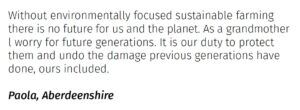It’s now a month since COP15 in Montreal. The COP15 summit gave us commitments to global nature targets to halt the loss of nature by 2030 and to restore it by 2050. We also saw commitments to conserve and manage 30% of the Earth’s land and seas for nature; halt the extinction of known species, pledges to halve the risk from pesticides and nutrient loss, reduce to near zero the loss of wildlife rich habitats and to reduce government subsides that harm nature. These are big promises – and it is absolutely necessary that we fulfil them.
We already know we need to reach net zero by 2045 in Scotland. Now, we also know we need to have reversed and restored nature to be nature positive by 2050. That means doing things differently, implementing actions swiftly and aligning them so that actions for climate do not damage nature.
The global leadership from Montreal is important in setting a direction of travel. We will only walk that path however, if we all commit to supporting necessary action, and this is going to mean tough choices: tougher than flying less and phasing out fossil fuel, which are going to seem rather easy in comparison.
Beyond the headlines, what we need now are effective actions. Targets are important but what really counts is delivery. What will that look like in Scotland? It will need to look a bit like this:
Creating Nature networks to restore and protect our habitats, building wider ecosystem resilience to change. We do this through planning reform, land use planning and land use support as well as action on the ground.
Managing our wider landscapes and seas for biodiversity: deer numbers at levels that do not irrevocably damage their habitats, about 5 deer per km, and fishing that does not diminish and weaken fish populations.
Investment in nature restoration at habitat and species level: improving the quality of habitats like river woodlands, mountain woodlands, species rich grasslands and upland heaths for example. Rebuilding species populations to levels where they can sustain themselves: species like twinflower, juniper, curlew and lapwing, freshwater pearl mussel and dark bordered beauty moth.
Getting real about private investment in nature: recognising the risks of greenwashing and the traps of credits; being strategic about using public funding to kick start initiatives and fill in funding gaps
Protecting ecosystems from the main drivers of loss: pollution, habitat fragmentation and loss, over exploitation.
Reforming farming subsidy: shifting subsidy to nature and climate positive action, nature positive food production and away from damaging activities.
COP15 wasn’t really about agreeing action on the ground though. It was more about a strategic approach to ensuring action on the ground is effective to save nature. Success will depend on nature being right at the heart of government, in all parliamentary portfolios and at the forefront of the development of all government policy so we can all do our bit for nature.
To get there, we need leadership on biodiversity. Where will this leadership come from? It needs to come not just from Ministers, politicians and government: it needs to come from all of us. From young people who want to be able to see nature on their doorstep in decades to come, from grandparents who want their grandchildren to enjoy the wonder of nature just as they did as children and from society at large, who loves nature and wants to keep connecting with nature. This is no white flag: this needs to be our battle cry.

Quote from: Dear Cabinet Secretary, farming matters to Scotland’s’ people. 17 January 2023.
Blog written by Deborah Long, Chief Officer at LINK.
